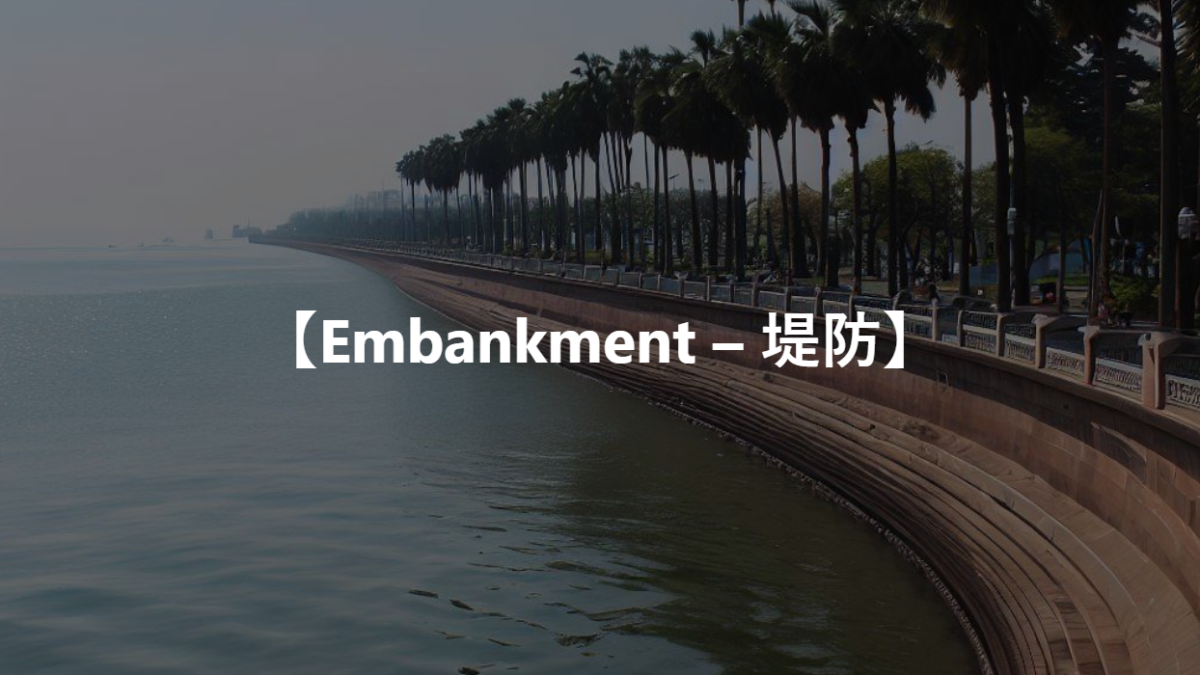語源・類義語・反対語・例文
【Embankment – 堤防】という単語の語源とか由来を知っていますか?
「Embankment」という単語は、主に土木工事や水管理に関連する用語です。この単語は、「en-」(内へ、を向けて)と「bank」(岸、堤)という二つの要素から成り立っています。もともと「bank」は古英語の「banke」から来ており、土や砂の小高い地形や、川の岸を指す言葉でした。
「Embankment」は、本来、水の流れを制御したり、洪水を防ぐために、土や石を積み上げて作られた堤や堤防を意味します。この言葉は、特定の土地を水害から守るために、人工的に高くした土地や、交通路(道路や鉄道など)の土手としても使われるようになりました。
したがって、「Embankment」は、人間が自然の地形を変更し、特定の目的(洪水防止、交通のため等)のために作り出した人工的な土の盛り上がりや堤防を指す言葉として発展してきました。
The word “Embankment” is primarily associated with civil engineering and water management. This term is composed of two elements: ‘en-‘ (into, towards) and ‘bank’, which originally comes from the Old English ‘banke’, denoting a raised terrain of earth or sand, or the edge of a river.
“Embankment” specifically refers to a bank or mound built up to control the flow of water or to prevent flooding, created by stacking earth or stones. This term has also come to be used for artificially raised areas of land designed to protect a region from flooding, or as embankments for transportation routes, such as roads and railways.
Thus, “Embankment” has evolved to denote an artificial rise of earth created by human intervention to alter the natural landscape for specific purposes, such as flood prevention or transportation.
この単語の類義語・反対語を教えてください。
類義語:
- Levee (堤防): 洪水を防ぐために川沿いに作られる長い土堤。
- Dike (堤防、堰): 特に水を防ぐために作られた土や石の壁。
- Dam (ダム): 水の流れを制御するために建設される、より大きな構造物。
- Mound (土塁、塚): 一般的には小高い土の山や盛り土。
- Bank (岸辺): 自然の地形や、水辺を形成する土の盛り上がり。
反対語:
- Trench (溝、トレンチ): 土を掘って作る長い狭い穴や溝。
- Ditch (溝、排水溝): 土地から水を排除するために掘られた浅い溝。
- Valley (谷): 地形の低い部分で、周囲よりも低く、しばしば川が流れる。
- Depression (低地): 地面が周囲よりも低くなっている地形の部分。
- Basin (盆地、流域): 周囲よりも低い地形で、水が集まりやすい地域。
この単語に似た単語で間違いやすい単語はありますか?
- Embarkment: これは実際には正しい英単語ではありませんが、「Embark」(乗り出す、船出する)と「Embankment」を混同して作られがちな誤った形です。正しくは「Embarkation」という単語で、船に乗ることや旅行の開始を意味します。
- Enchantment: 発音が似ていますが、「魅了」や「魔法」を意味し、「Embankment」とは全く異なる概念です。
- Embank: これは「Embankment」の動詞形で、土手を築くまたは強化する行為を意味しますが、単体で使われることは少なく、意味の違いに注意が必要です。
この単語を使った例文を5つほど教えてください。
The river was protected by a strong embankment to prevent flooding.
川は洪水を防ぐために堅固な堤防で保護されていました。
We took a walk along the embankment and enjoyed the view of the city skyline.
堤防を歩いて市のスカイラインの景色を楽しみました。
The construction crew is working on reinforcing the embankment to withstand future storms.
建設クルーが堤防を強化して将来の嵐に耐えるよう作業を行っています。
The embankment provides a barrier between the railway and the residential area.
堤防は鉄道と住宅地の間にバリアを提供しています。
People gathered on the embankment to watch the fireworks display over the river.
人々は川上で行われる花火大会を見るために堤防に集まりました。
【Embankment – 堤防】のコロケーション
- River embankment (川の堤防): 川の両岸を強化し、洪水を防ぐために作られた堤防です。これは、水害防止や土地保全のために重要な構造物となります。
- Embankment construction (堤防の建設): 堤防を建設する過程を指します。この作業には、土砂の運搬、盛り土、そして堤防の形成が含まれます。
- Coastal embankment (沿岸の堤防): 海岸線に設けられ、潮の満ち引きや高波から陸地を守るための堤防です。海岸侵食を防ぐためにも用いられます。
- Embankment protection (堤防の保護): 堤防が侵食や破損から守られるようにするための措置です。これには、植生の植え付けや岩石の配置などが含まれます。
- Embankment failure (堤防の破損): 堤防が損傷したり、機能を果たさなくなったりする状況を指します。このような状況は、大きな洪水のリスクを引き起こす可能性があります。
「Embankment」、つまり堤防に関連する用語は、特に土木工学や洪水管理の分野で広く用いられます。例えば、「River embankment」は、洪水防止を目的として川沿いに構築された堤防を指します。これらの堤防は、過剰な水流が周囲の地域に流出するのを防ぎ、人々の生活や財産を保護する重要な役割を担っています。
また、「Embankment construction」というフレーズは、このような堤防を築くプロセスを示します。この建設プロセスには、大量の土砂を運び、特定の場所に積み上げ、堤防を形成する作業が含まれます。これは、地域社会を洪水から守るための基本的かつ重要な工程です。
「Coastal embankment」は、特に海岸線に沿って築かれる堤防を指し、高潮や嵐から陸地を保護します。これらの堤防は、海岸侵食を防ぐ上でも非常に重要であり、しばしば沿岸のコミュニティを守る最後の防衛線となります。
一方で、「Embankment protection」は、既存の堤防を維持し、その機能を長期間にわたり保持するための措置を指します。これには、侵食を防ぐための植生の植え付けや、堤防を補強するための岩石の配置などが含まれます。
最後に、「Embankment failure」という言葉は、堤防が損傷したり、その機能を失ったりした状況を指します。これは重大な洪水のリスクをもたらすため、堤防の監視と維持は非常に重要です。
これらのコロケーションを通じて、「Embankment」の用語が、いかに洪水防止や土木プロジェクトにおいて重要な役割を果たしているかが分かります。
The term “Embankment” is widely used, particularly in the fields of civil engineering and flood management. For instance, “River embankment” refers to the banks constructed alongside rivers to prevent flooding. These embankments play a crucial role in preventing excessive water flow from inundating surrounding areas, thereby protecting the lives and properties of people.
Furthermore, the phrase “Embankment construction” denotes the process of building these protective banks. This construction process involves transporting large amounts of earth and soil, piling them up at specific locations, and forming embankments. This is a fundamental and critical step in safeguarding communities from flooding.
“Coastal embankment” specifically points to embankments built along coastlines to protect the land from high tides and storms. These embankments are vitally important in preventing coastal erosion and often serve as the last line of defense for coastal communities.
On the other hand, “Embankment protection” refers to measures taken to maintain existing embankments and ensure their functionality over the long term. This includes planting vegetation to prevent erosion and placing rocks to reinforce the embankments.
Lastly, the term “Embankment failure” describes situations where embankments are damaged or lose their functionality. This poses a significant risk of flooding, highlighting the importance of monitoring and maintaining embankments.
Through these collocations, we can see how the term “Embankment” plays a vital role in flood prevention and civil engineering projects.
文法問題: “Embankment” (堤防)
- 単数形・複数形:
The _ along the river prevented the floodwaters from reaching the town.
(A) embankment
(B) embankments
(C) embankment’s
(D) embankments’
解答と解説: (A) embankment
embankment は可算名詞ですが、ここでは特定の1つの堤防を指しているため、単数形が適切です。
– - 冠詞との組み合わせ:
The engineers inspected _ to ensure its structural integrity.
(A) a embankment
(B) an embankment
(C) the embankment
(D) embankment
解答と解説: (C) the embankment
特定の堤防について言及しているため、定冠詞 the が必要です。
– - 前置詞との組み合わせ:
The children played of the , enjoying the view of the river.
(A) on top / embankment
(B) at top / embankment
(C) in top / embankment
(D) to top / embankment
解答と解説: (A) on top / embankment
「堤防の上で」という意味で、on top of the embankment が適切です。
– - 文脈に合った表現:
The _ was built to protect the city from flooding.
(A) embankment
(B) levee
(C) dike
(D) all of the above
解答と解説: (D) all of the above
embankment, levee, dike はいずれも「堤防」という意味で、この文脈ではすべて適切です。
– - 誤文訂正:
The embankments were reinforced to withstand the force of the rising river.
解答と解説: 誤りはありません。
この文は、「堤防は、増水する川の力に耐えられるように補強された」という意味で、embankments が正しく使われています。

